Sales: Sales Workflows: Creating Quotations + Sales Orders
Purpose
This document will go over the steps needed to create a new Quotation and the resultant steps to reach the Delivery stage within the Odoo 13 Sales App.
Quotations are the initial state of a Sale Order, meaning that every Sale Order begins as a Quotation. Depending on your business, you may immediately confirm Quotations into Sale Orders, or you may send the quotation to the customer for review, either in PDF format or online, before it becomes a confirmed Sale Order.
Process
To get started, navigate to the Sales App

Creating the Quotation
After opening the Sales application, you will see a list of all your current quotations. Click CREATE. This opens the New Quotation form.

On the Quotation, you will see the following fields:
Customer: The name of the contact ordering the products. Depending on the information provided for the contact, the Invoice Address, Delivery Address, Payment Terms, and Delivery Method may populate from the database, but can still be manually edited if needed.
Invoice Address: Where the Invoice for this order will be billed to.
Delivery Address: Where the product will be delivered.
Quotation Template: A prebuilt Quotation that will automatically add specific products and optional products to the Quotation.
Expiration: The date when the terms and pricing in this quotation expire
Pricelist: Whether there is a custom pricelist assigned to this customer.
Payment Terms: The conditions and timelines that affect when payment must be completed for this order.
Order Lines
After filling in the fields above, you will see three tabs called Order Lines, Optional Products, and Other Information. Dependign on the other apps installed to your database, you may see additional tabs.
Open the Order Lines tab and you will see following fields:
Product: The item that will be sold to the customer. Fills in the Description, Unit of Measure, Unit Price, and Taxes depending on the product information. They can be manually edited.
Description: More detail about the product that is displayed on the website and the order to the customer, if the Description for Customers field on the product is filled in. Otherwise, will display the product name.
Quantity: The number of the product being requested by the customer.
Unit of Measure (UoM): How the product selected is measured in quantity.
Taxes: Allows you to apply the necessary taxes in conjunction with the Accounting app. Taxes will be automatically applied based on the product's Customer Taxes configuration and/or the Fiscal Position (compatible with TaxCloud), which can be set on the customer or order level. A tax can also be manually selected if needed.
Disc.%: The applied discount.
Subtotal: The Total untaxed amount based on the Ordered Qty.
Additional columns are available in the menu on the far-right side of the header row. You can check and uncheck to manage visibility of these columns.

Good to Know!
When selecting your Product(s), iif there isn't enough stock in your inventory you will see the icon next to the entered quantity.

When you click this icon, you'll get further details about current and forecasted stock.
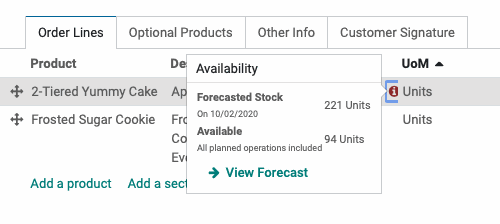
As items are added to the Quotation, at the bottom right you will see a summary of the Untaxed Amount, Taxes, Total (a combined total of both Subtotal and Taxes), and Margin. In order to customize the Terms and Conditions section, see the Sales Configuration Document.
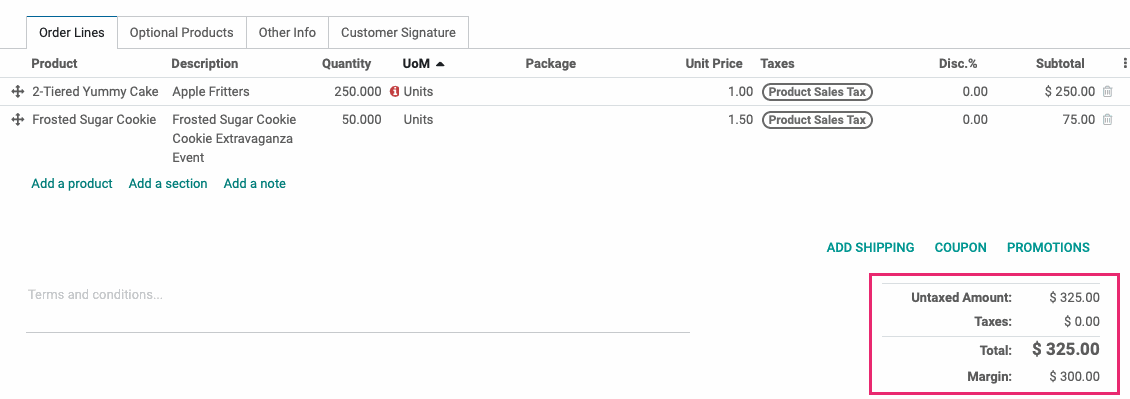
Optional Products
After settings up the products, move to the Optional Products tab to continue. You may wish to add Optional Products when the main product being sold has a relationship to another item. For instance, when purchasing a desk an optional product would be a chair to go with the desk. This gives the Customer the option of adding these items onto their order if they are interested in doing so.
When the customer is viewing the Quotation online, they will see the Optional Products and can add them with the Icon. Items added to Optional Products will not be included in the Total for the order until the customer adds them from the online Quotation.

Other Information
Click the Other Info tab after selecting the Optional Products. Within this tab you will see at least three sections, possibly more depending on your database configuration:
Sales Information
Salesperson: The User responsible for finalizing and keeping track of this Quotation.
Sales Team: The sales team of the Salesperson on the order.
Customer Reference: How the customer refers to this Order, allowing for easier communication between the Salesperson and Customer. For instance, this could be SOXXX to the user, while being POXXX for the customer.
Invoicing
Fiscal Position: Fiscal Positions provide tax mappings and can be configured for use with TaxCloud for automatic tax calculations based on state, county, and city-specific tax rates.
Shipping Information
Shipping Policy: Allows you to indicate if products should ship as stock becomes available or if the order should be held until all products on the order are ready for delivery.
Delivery Date: The date the delivery was promised to the customer.
Expected Date: The date when the customer can be prepared to receive their products. Automatically generated based on product lead times and the specific Shipping Policy.
Effective Date: The date the order was shipped. For the "Deliver each product when available" Shipping Policy, the date the first transfer is Validated becomes the Effective Date.
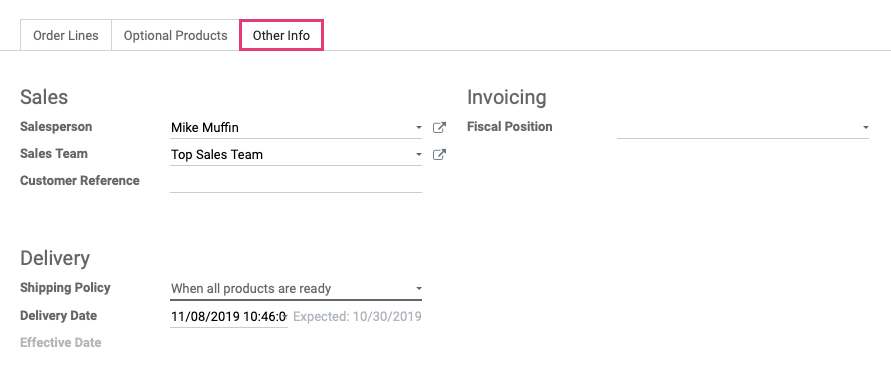
Final Steps
Delivery Method + Shipping Costs
The final step before sending your quotation out to the customer for confirmation is getting the delivery charges based on the Delivery Method chosen and the weight of the product. From the Order Lines tab, click the Add Shipping button just above the order totals.

Important!
Make sure that the Customer has added all the wanted optional products before calculating the delivery charge or the delivery charge will not be accurate.
This will present you with a pop-up window where you'll select the Shipping Method, then click Get Rate next to the Cost label. It will automatically calculate the Delivery charge based on the two factors mentioned above, and a ADD will appear that will add the charge to your Quotation.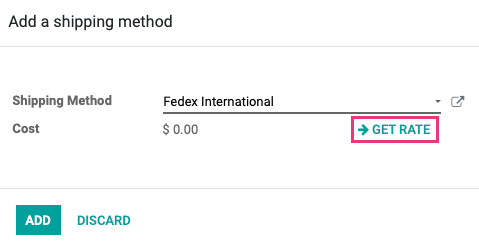
You can change the Shipping Method to other carriers and GET RATE as many times as needed until you find the one you wish to use. At that point, click Add.
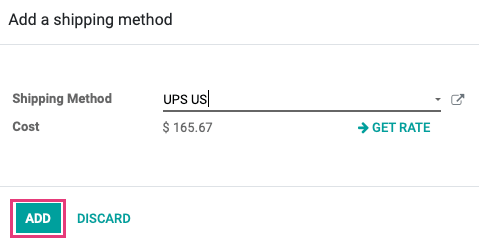
The Shipping Cost will be added to your invoice as a line item.

Once the Quotation is ready, press the SEND BY EMAIL button. A pop-up modal will display the email that will send and, after hitting Send, an email will be sent to all followers of the Quotation. The status will also change from Quotation to Quotation Sent.
When the customer accepts the Quotation online, it will move to the final status and become a Sales Order. Alternatively, if online quotations are not a part of your business workflow, you can press the CONFIRM button.
 Once it becomes a confirmed Sales Order, you will see a Delivery
Once it becomes a confirmed Sales Order, you will see a Delivery 